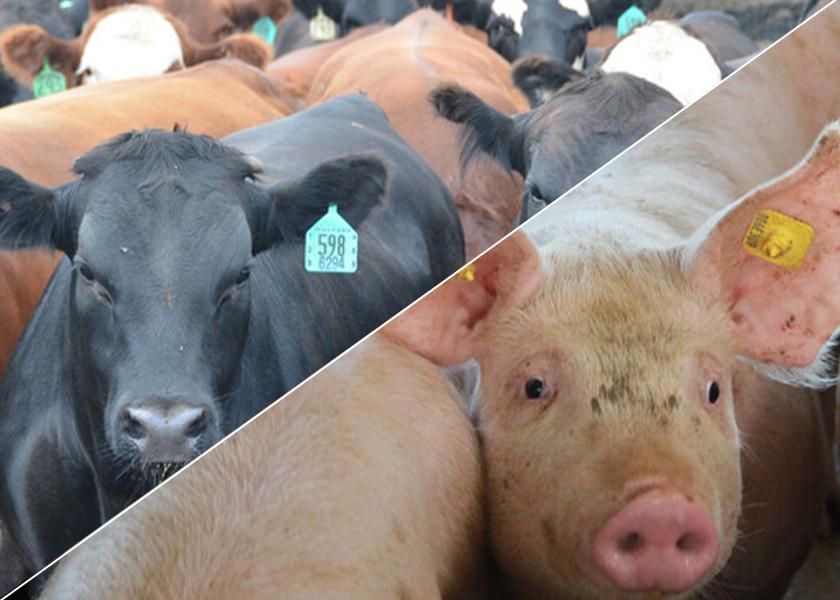Livestock Analysis | June 15, 2022

Price action: July lean hog futures rose $1.65 to $108.275, the contract’s highest closing price since June 7. Late-summer and fall contracts posted smaller gains, while December futures eased slightly.
Fundamental analysis: Nearby lean hogs rose a fourth consecutive session and settled at the highest level in over a week on support from renewed cash market strength. The CME lean hog index rose 73 cents to a 10-month high at $108.13 (as of June 13) and is expected to gain another 44 cents tomorrow. July futures’ recent rally has erased a discount to the index, with the nearby contract now at a premium of 14.5 cents. The lack of a futures’ discount to cash, combined with a sharp drop in wholesale pork early today, could mute followthrough buying interest. Pork cutout values fell $3.95 this morning to $104.72, led by a decline of over $12 in bellies, but movement continued to be strong at 170 loads.
Technical analysis: Nearby futures charts turned slightly more bullish with today’s firm close, though the market remains in a broader 2 1/2-month downtrend and appears to be settling into a sideways consolidation pattern between the early-June high at $114.00 and this week’s low at $103.525. Initial resistance in July futures comes in at the 40-day moving average of $108.955 and the 50-day moving average just under $110.80. Initial support is seen at $105.00 and last week’s low.
What to do: Be prepared to extend feed coverage on price weakness.
Hedgers: Carry all risk in the cash market for now.
Feed needs: You should have all corn-for-feed needs covered through mid-June. You are hand-to-mouth on soybean meal needs.
Price action: August live cattle soared $2.725 to $136.80. August feeders rose $1.975 to $173.275.
Fundamental analysis: Reports that soaring temperatures in the Plains have killed thousands of head of cattle spurred futures higher. Death losses will reduce feedlot supplies, but the heat stress will very likely cause the survivors to stop growing and reduce animals’ readiness for slaughter. While the situation in southern markets isn’t as severe, the northern markets will surely see significantly fewer animals coming out of feedlots in the short term. How quickly those cattle will recover from the heat is open to question but another heat wave next week suggests the recovery won’t be quick.
The more plentiful supplies in the south should alleviate the situation somewhat, and tend to limit price gains, but the discounts built into the nearby contracts now look overly large. That is, USDA reported the average price of steers traded on Monday and Tuesday at $143.81, up over $2.00 from Monday’s average at $141.72 and almost $4.00 over last week’s mean. Thus, the nearby contracts ended the day $6.00-$7.00 under this week’s early average. The June contract looks particularly underpriced.
The surge in fed cattle values clearly spilled over into feeder futures, although gains in the latter seem likely to be somewhat diminished by feedlot manager reluctance to place (and have to maintain) yearlings in their lots with the heat dome hanging over their heads. Fresh soybean meal strength may also have weighed upon bids for feeders.
Technical analysis: Today’s surge flipped the technical advantage in August cattle futures back to the bulls, especially with the opening gap spanning the contract’s 40-day moving average. Today’s low at $135.25 now represents initial support, with strong backing from the 40-day moving average at $134.96. Look for additional support at yesterday’s low of $133.425, with a drop below that point likely to again have bears targeting the $130.00 level. Today’s high places initial resistance at $137.50, with backing from last Thursday’s top at $137.95. A breakout above that level would open the door to a retest of the April 25 chart gap between $138.75 and $140.275.
Bulls in August feeder futures also seem to hold the technical advantage at this point, although bulls couldn’t force a close above initial resistance at the contract’s 10-day moving average of $173.31. That’s backed by the top end of Monday’s chart gap at $174.025, then by last Thursday’s high at $176.875. A close above that point would have bulls targeting the May high at $177.50, then the March high at $182.10. Initial support at today’s low of $172.30 is backed by the 40-day moving average at $171.00, then by the 20-day moving average at $169.90. A drop below those levels would open the door to a bearish test of the May 31 low at $164.75, then the May 23 contract low of $162.80.
What to do: Be prepared to extend feed coverage on a pullback to the recent lows.
Hedgers: Carry all risk in the cash market for now.
Feed needs: You are hand-to-mouth on corn-for-feed and soybean meal needs.






